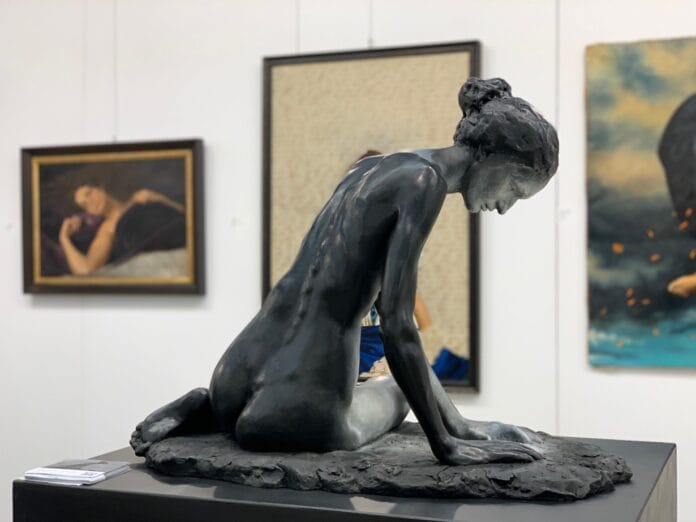Maudie Brady’s artistic journey is one defined by exploration, mastery, and an enduring pursuit of truth through form. A native of Australia, she began her academic path at the University of Melbourne, where she earned her Bachelor of Arts in 1995. Her passion for the physicality of form and space soon led her to the Royal Melbourne Institute of Technology, where she completed a Bachelor of Fine Arts in Sculpture in 1998. These early years laid the groundwork for a lifelong fascination with the human figure and the emotional depth it can convey through sculptural expression.
After graduation, Brady embarked on a successful 12-year career in the film and television industry. Yet, amid the creative demands of that world, she found herself longing for a deeper, more tactile engagement with artistic creation. This introspection prompted a pivotal decision to return to fine art and dedicate herself to the mastery of figurative sculpture.
Her search for artistic refinement brought her to Italy, where she studied at the renowned Florence Academy of Art (FAA). Immersed in the classical traditions of European sculpture, Brady refined her technical precision while embracing the expressive potential of the human form. She completed her Figurative Sculpture Diploma at the Florence Academy in 2016, graduating with a scholarship and the distinction of exceptional achievement. Today, she continues her association with the Academy as both a teacher and a leader, serving as the Director of Anatomy and Écorché Sculpture. Through this role, she carries forward the time-honored techniques of the Old Masters, bridging centuries of artistic knowledge with contemporary relevance.
Achievements and Recognition
Maudie Brady’s dedication to craftsmanship and narrative depth has garnered widespread recognition in the international art world. Her works have been celebrated for their emotional resonance, anatomical precision, and philosophical underpinnings.
Among her many accolades, Brady received The Society’s Prize for FACE2019, as well as joint wins for the Tom Bass Prize in both 2016 and 2022, a testament to her consistency and artistic evolution over time. Her life-size sculpture, Laura earned the title of Best Nude at the 12th ARC International Salon Competition, a prestigious global platform recognizing excellence in realist art.
The success of Laura was further cemented when it was acquired by the Museo Europeo de Arte Moderno (MEAM) in Barcelona in 2017, joining the museum’s Permanent Collection. MEAM’s recognition affirmed Brady’s standing as a sculptor whose works transcend geography and era, uniting classical technique with universal emotion.
Her later works, Wounded Faun, Muninn’s Fate, and Forsaken Son received Honorable Mentions in both the 13th and 14th ARC International Salons, each piece contributing to her growing reputation as an artist who channels profound human experiences through bronze and clay. Today, Brady’s sculptures reside in public and private collections around the world, admired by collectors who seek both beauty and depth in contemporary realism.
Artistic Vision
Brady’s art is deeply rooted in the human condition, an exploration of vulnerability, endurance, and transcendence. Her figures, often mythological or allegorical, are conduits for emotional truths that transcend language.
Drawing on classical training yet unafraid to explore modern contexts, Brady’s sculptures bridge the ancient and the present. Each work invites viewers to contemplate the tension between fragility and strength, between what is broken and what endures.
Her anatomical expertise allows her to sculpt not just bodies, but beings imbued with spirit, narrative, and tension. Through surface texture, gesture, and form, Brady conveys emotions that feel both personal and archetypal. Whether rendered in clay, bronze, or other media, her figures stand as quiet witnesses to the complexity of human faith and perseverance.
About the Artwork: “Seeker”
Among Maudie Brady’s compelling body of work, Seeker stands out as a profound meditation on faith and resilience. This 2/3 life-scale sculpture, modeled in clay for bronze casting, captures the essence of hope emerging from desolation.
In Seeker, the earth itself becomes a metaphor cracked open, yet illuminated from within. From this fractured ground, light spills forth, symbolizing the persistence of hope even in the most barren landscapes. The figure, poised between struggle and revelation, embodies the timeless human desire to find meaning amidst chaos.
Brady’s mastery of anatomy and gesture is evident in the sculpture’s dynamic composition. The tactile surfaces invite viewers to trace the contours of emotion and transformation. Through this interplay of shadow and illumination, Seeker communicates not only the endurance of faith but also the beauty of vulnerability, a reminder that even through life’s fractures, something luminous can emerge.
Legacy and Continuing Influence
As both an artist and educator, Maudie Brady represents the living continuum of figurative art. Her commitment to teaching at the Florence Academy of Art ensures that the next generation of sculptors inherits not just technique, but also the philosophical foundation of her practice, the belief that art is a vessel for truth, emotion, and human connection.
Her sculptures, whether housed in museums or private collections, invite contemplation and dialogue. They remind us that in the stillness of form, movement endures; in the solidity of bronze, emotion breathes; and in the silence of art, faith speaks.
Conclusion
Maudie Brady’s art invites us to look beyond the surface to see the strength that lies within struggle and the light that breaks through darkness. Through works like Seeker, she captures the delicate balance between despair and hope, grounding timeless human stories in material form. Her journey, from Australia to Italy and across the international art world, reflects a devotion not only to sculpture but to the act of seeking itself, a lifelong pursuit of beauty, meaning, and truth carved in clay and cast in bronze.


